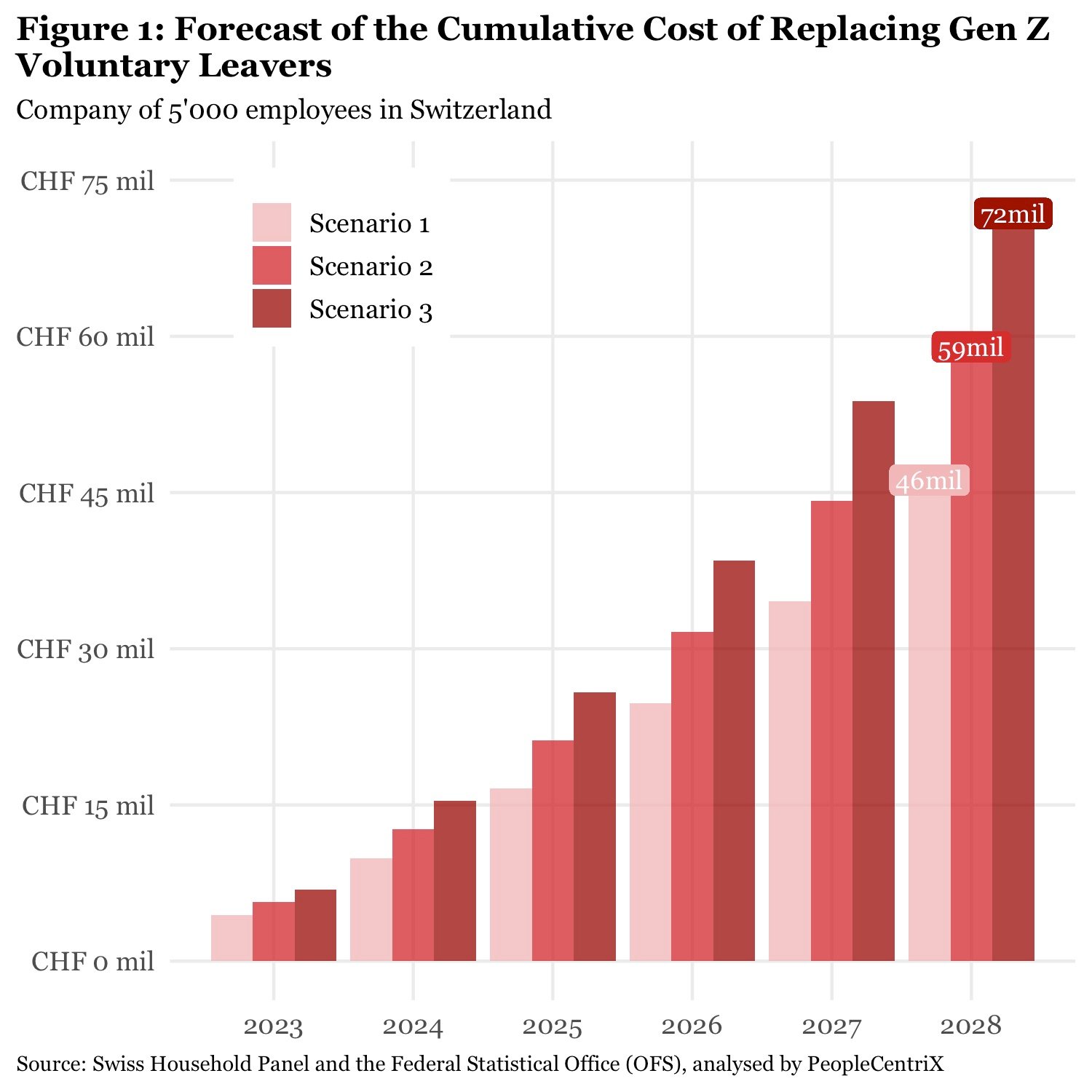- The number of Gen Z employees in Switzerland is forecasted to grow by 527’000, or 66%, in the next five years, reaching 25% of the total workforce in 2028.
- We estimate that 23% of Gen Z workers are likely to voluntarily leave their jobs in 2023, with a 95% confidence interval of 18% to 28%.
- In a company of 5’000 employees, the cumulative cost of replacing Gen Z employees who resign could reach, at best, CHF 46 million, and, at worst, CHF 72 million from 2023 to 2028.
This article is the second in a three-part series on “Myths & Truths about the Great Resignation in Switzerland: A Longitudinal Study of Generational Differences in Voluntary Turnover.” Read the first and third articles.
Warning: companies may face high levels of resignations from Gen Z
Our analysis of voluntary resignations in Switzerland revealed that companies could face high levels of attrition from Gen Z workers, born between 1997 and 2012, just as this generation of employees is set to make up a growing share of the workforce in the next decade. Business leaders should brace their organisations to avoid substantial financial impacts. In this article, we will illustrate the consequences of inaction by examining three different scenarios.
We estimate that 1 in 5 Gen Z workers in Switzerland will voluntarily leave their job during 2023
The Federal Statistical Office of Switzerland forecasts the number of Gen Z employees to grow by 527’000, or 66%, in the next five years, reaching 25% of the total workforce in 2028.
Our model predicts that 23% of Gen Z workers are likely to quit their jobs in 2023, with a 95% confidence interval of 18% to 28%. If we assume the number of voluntary resignations among Gen Z employees continues to grow by 10% a year, which our model predicts it has since 2014, then we can project what level of turnover companies could face from their Gen Z workforce in the next five years. Further, we can calculate how much this increased turnover might cost by estimating the price of replacing these employees (Figure 1).a
A case with a firm of 5’000 employees
Predictions about the future are always uncertain, so our scenario is meant to be illustrative rather than prescriptive. We also recognise that our example is relatively abstract, but we believe it might provide a glimpse into the future given current trends.
These caveats aside, let’s imagine a firm:
- of 5’000 employees;
- with the same share of Gen Z employees than the total workforce (i.e., 16% in 2023);
- with a growing number of Gen Z employees leaving their jobs voluntarily (i.e., 10% increase each year);
- replacing each Gen Z employee that leaves voluntarily at the cost of CHF 31’713 per leaver.b

First scenario - starting from 18% of Gen Z voluntary leavers in 2023
From our model’s lowest estimate of 18%, we can detail the first scenario. In this case, the share of voluntary resignations among Gen Z workers is predicted to reach 29% by 2028. In a workforce of 5’000, this amounts to 1’456 voluntary leavers from 2023 to 2028. If the company did not act to retain these employees, replacing them would cost CHF 46 million.
Second scenario - starting from 23% of Gen Z voluntary leavers in 2023
In the next scenario, the share of Gen Z workers voluntarily leaving their job is projected to grow from 23% in 2023 to 37% in 2028. In the example firm, this means 1’860 Gen Z workers are likely to quit their jobs over this period. If our company does not act to retain these employees, the price tag for replacing them is projected to reach CHF 59 million.
Third scenario - starting from 28% of Gen Z voluntary leavers in 2023
In the last scenario, we estimate the share of Gen Z workers voluntarily exiting their jobs to grow from 28% in 2023 to 45% in 2028, representing approximately 2’265 Gen Z resignations for the firm. This turnover would cost the company CHF 72 million to replace. At first glance, a rate of voluntary turnover of 45% among Gen Zers seems high, but if we consider the fact that more than 50% of Swiss workers said they were ready to quit their jobs in 2022, it appears relatively reasonable; even if, admittedly, 45% remains at the highest end of the predicted spectrum.1
What will you do before 2028?
If the current trends persist, our scenario analysis projects voluntary turnover among Gen Z employees could cost a company of 5’000 between CHF 46 to CHF 72 million in the next five years. On its own, this financial burden should warrant action from business leaders. Yet, we also believe it represents an opportunity for forward-driven companies to future-proof their organisations.
To nip the Gen Z turnover in the bud, companies should adopt people-centric practices, which means understanding the expectations of their workforce, and co-designing work experiences that align with these expectations. We believe this is the best way to unleash employees’ potential and retain them. In the third article of this three-part series, we dive deeper into our recommendations.
AUTHORS
Tanguy Dulac, Founder & CEO of PeopleCentriX
Bruno Alves de Carvalho, Analyst & Lead Researcher at PeopleCentriX
Lily Unell, Analyst at PeopleCentriX
REFERENCES
-
Randstad. A New Era in the #Homework Revolution. https://www.randstad.cz/s3fs-media/cz/public/2022-04/Randstad_Workmonitor_2022.pdf (2022).
DATA
SHP Group, Living in Switzerland Waves 1-22 + Beta version wave 23 + Covid 19 data [Dataset]. FORS - Swiss Centre of Expertise in the Social Sciences. Distributed by SWISSUbase, Lausanne, 2022. DOI: https://doi.org/10.48573/vaxa-3w42
Federal Statistical Office. Scénarios de l’évolution de la population active 2020-2050. https://www.pxweb.bfs.admin.ch/pxweb/fr/px-x-0301000000_101/px-x-0301000000_101/px-x-0301000000_101.px/ (2022).
FOOTNOTES
- Note our scenario analysis is not an exercise in scenario planning, which is more complex. For example, we do not consider what factors may increase or decrease the annual growth of turnover among Gen Z employees below or above 10% from 2023 to 2028.
- Research by the Society of Human Resource Management (SHRM) suggests that the cost of hiring can reach 50% to 60% of an employee’s annual salary (available at: https://www.shrm.org/resourcesandtools/hr-topics/benefits/pages/shrm-hr-benchmarking-reports-launch-as-a-member-exclusive-benefit.aspx). For our example, we valued the cost of hiring at 50% of the median salary of a Swiss worker aged 20 to 29, which was 63’426 CHF in 2020.





